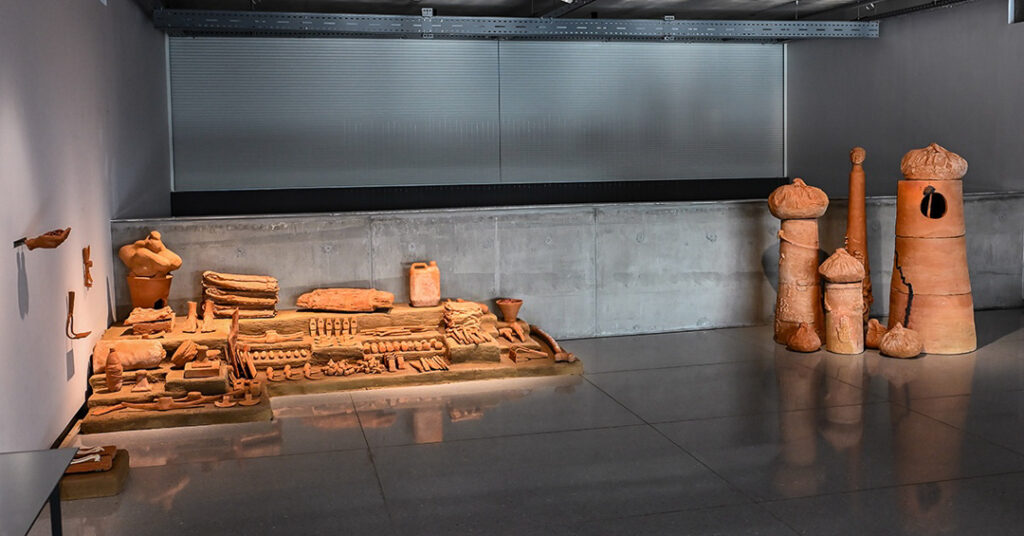Our March Laurel goes to Birender Kumar Yadav for his terracotta installation in homage to brick kiln workers, one of the highlights of the Indian Ceramics Triennale.
The project documents the lives of brick kiln workers in the city of Mirzapur, about sixty per cent of whom are lower-caste migrant seasonal workers. As migrant labourers from the bordering Bihar or Jharkhand regions, they work long hours and suffer malnutrition. Most brick kiln workers suffer broken ribs from the hard work. Children do not go to school. The season extends from November to June, after which their temporary homes are demolished.
Over the years Yadav has relayed their plight through media such as sculpture, photography, and installation. In Re-presenting from the traces, Yadav made casts of ordinary artifacts left behind after demolition, reframing them as sculptures. Through small gestures and everyday objects, Yadav’s work carries a large emotional registry, yet he remains conscious of the gap between the objects and the lived experiences of the workers; conscious that the object’s emotional value lies in an original that no longer exists.
a saying among the workers that states that you cannot balance the bricks until you have broken a rib
After each working season, the temporary houses in which these workers live are destroyed. In Re-presenting from the traces, Yadav has collected some of the things left after the temporary dwellings have been demolished. He then made casts of the objects and transformed them into sculptures of terracotta. One of the works, which looks like a wave, refers to a saying among the workers that states that you cannot balance the bricks until you have broken a rib. Most people who work in the kilns have one or more broken ribs due to the hard work.
Yadav has for several years, and through various media, such as sculpture, photography, and installation, examined the working conditions in brick production in Uttar Pradesh. In Re-presented from traces, he depicts small gestures and everyday objects. But he does it knowing that there is a gap between the stories he tells and the experiences of the brick workers; a distance marked both by the fact that the objects he creates originate from something that no longer exists and by the charge found in bodily and everyday things. Objects whose emotional value can never be fully translated.
- Birender Kumar Yadav, Details of Re-presented from Traces, Terracotta; photo: Krishna Singh
- Birender Kumar Yadav, Details of Re-presented from Traces, Terracotta; photo: Krishna Singh
- Birender Kumar Yadav, Details of Re-presented from Traces, Terracotta; photo: Krishna Singh
Birender Kuma Yadav writes about the making of the work:
This work happened as the organic outcome of my engagement with brick klin workers since the time of my college. I used to visit the brick kiln workers regularly first to know then to document and gradually started doing things collaboratively. I conducted workshops for the brick workers’ children for a long time. In due course, we developed a very good camaraderie. Earlier I used some of their tools and objects directly and created some installations.
During the pandemic, I was stationed in Delhi and couldn’t visit the brick workers’ place in Varanasi. Though I had regular conversations with them, I couldn’t go there physically. But this also gave me a space and perspective to see my engagement from a distance. I gained clarity about my practice and engagement with the workers’ issues. That reflection led to this present body of work.
Most of the works are cast from the leftovers, tools and other objects of the workers when they vacate their temporary dwellings after the work is over at a site. Some of them I had to create. This installation is a mixture of directly terracotta-cast objects and my reflections in my linguistic frameworks. These were cast in my studio in Delhi.
My studio is located in Ghitorni, a village located in between Vasant Kunj and Gurgaon. It is situated within the district of South West Delhi, Delhi, India. The village lies on the Mehrauli Gurgaon road and is also well connected by a metro station. Being well connected and having easy access helps me in many ways: to travel in and around Delhi and also to acquire materials for my works.
Follow @birender
See also the children′s workshop at the brick kiln.






